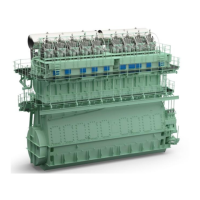Operation
0070−1/A1
Winterthur Gas & Diesel Ltd.
3/ 5
2.3 Load Range Limits
When the engine has the best values at CMCR (Rx), the limits that follow give the
load range of the engine:
D Line 1 is a constant mep or torque line through CMCR from 100% speed and
power down to 95% speed and power.
D Line 2 is the overload limit. This is a constant mep line from 100% power and
93.8% speed to 110% power and 103.2% speed. 103.2% speed is the
intersection point between the nominal propeller property and 110% power.
D Line 3 is the 104% speed limit where an engine can operate continuously. For Rx
with decreased speed (N
CMCR
0.98 N
MCR
) this limit can be extended to 106%,
but, the torsional vibration must not be more than the specified limits.
D Line 4 is the overspeed limit. The overspeed range between 104 (106) and 108%
speed is only permitted during sea trials if necessary. This is to demonstrate the
speed of the ship at CMCR power with a light running propeller in the presence of
authorized representatives of the engine builder. The torsional vibration must not
be more than the specified limits.
D Line 5 is the permitted torque limit from 95% power and speed to 45% power and
70% speed. This shows a curve defined by the equation: P
2
/P
1
= (N
2
/N
1
)
2.45
.
When the engine speed and power is near the data in Line 5 there will be a
decrease in scavenge air, which has an effect on the engine. The area between
Lines 1, 3 and 5 show the range in which the engine must be operated. The area
in the nominal propeller characteristic, 100% power and Line 3 is recommended
for continuous operation. The area between the nominal propeller property and
Line 5 must be reserved for acceleration, shallow water and usual flexibility of
operation.
D Line 6 gives the equation: P
2
/P
1
= (N
2
/N
1
)
2.45
through 100% power and 93.8%
speed and the maximum torque limit in transient conditions. The area above
Line 1 is the overload range. You must only operate the engine in this range for a
maximum of one hour during sea trails in the presence of authorized
representatives of the engine builder. The area between Lines 5 and 6 and the
constant torque line (shown as a dark area) must only be used for transient
conditions, i.e. during fast acceleration. This range is known as the service range
with operational time limit.
2014
The Relation between Engine and Propeller

